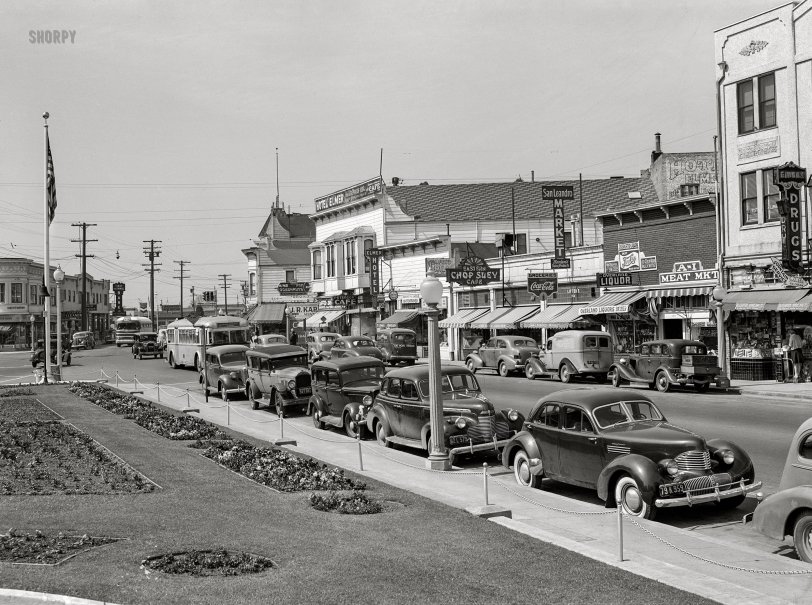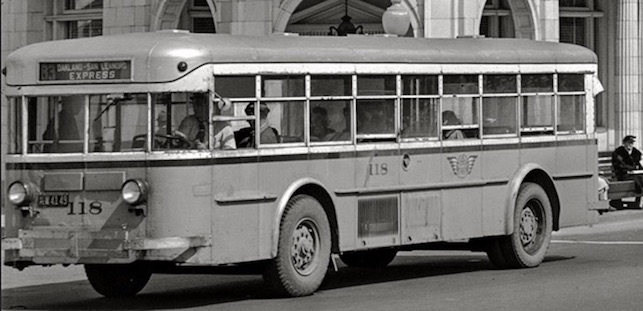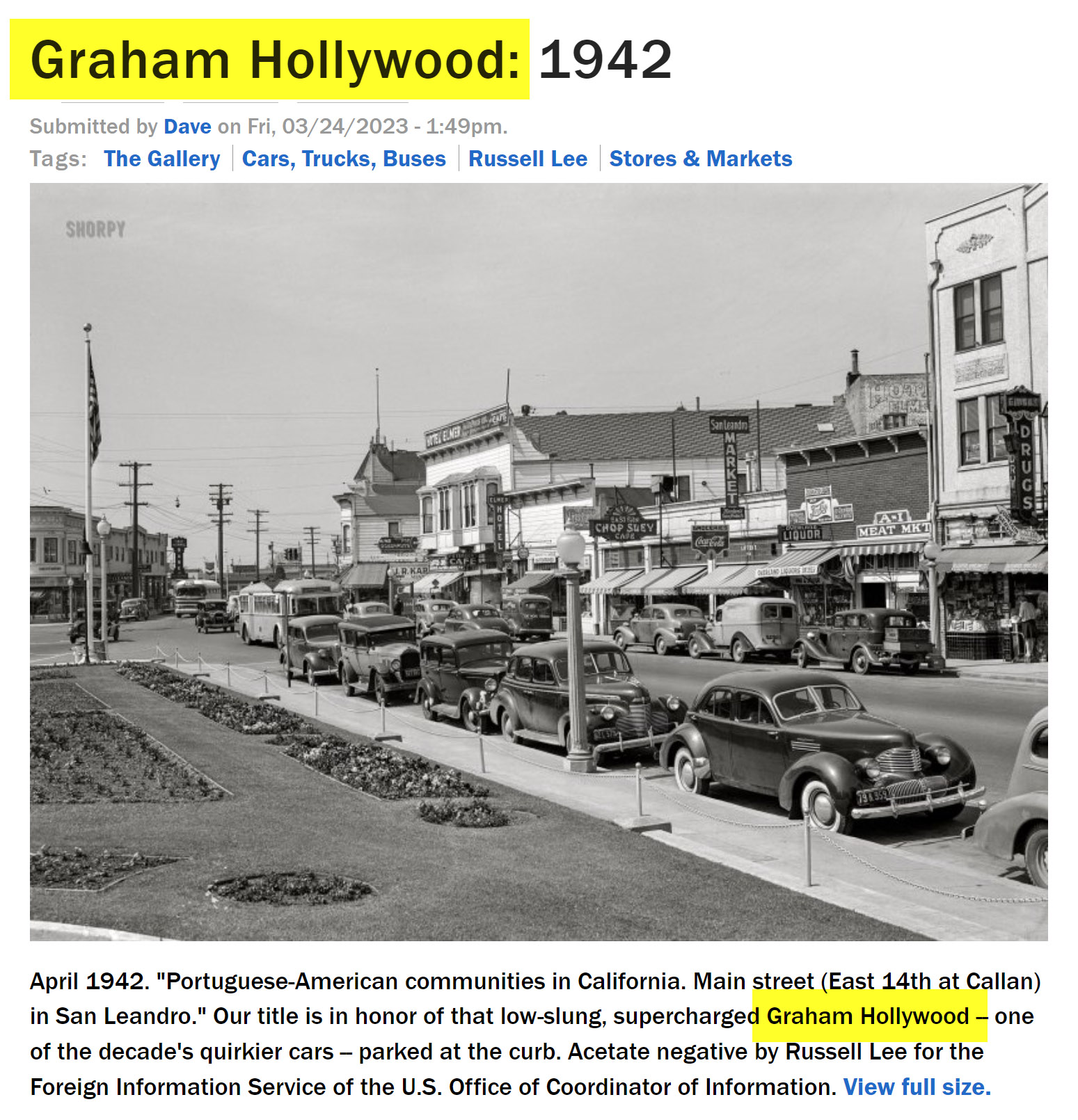


Framed or unframed, desk size to sofa size, printed by us in Arizona and Alabama since 2007. Explore now.
Shorpy is funded by you. Patreon contributors get an ad-free experience.
Learn more.

- Details, Details
- What's that building to the left of the tower?
- Coal Barges
- Bromo-Seltzer
- Inner harbor
- The Basin
- What a headache!
- Giant stepladder?
- Baldwin 62303
- Baldwin VO-1000
- Cold
- No expense spared
- Tough Guys
- Lost in Toyland
- And without gloves
- If I were a blindfolded time traveler
- Smoke Consumer Also Cooks
- Oh that stove!
- Possibly still there?
- What?!?
- $100 Reward
- Freeze Frame
- Texas Flyer wanted
- Just a Year Too Soon
- WWII -- Replacing men with women at the railroad crossing.
- Yes, Icing
- You kids drive me nuts!
- NOT An Easy Job
- I wonder
- Just add window boxes
Print Emporium
Graham Hollywood: 1942

April 1942. "Portuguese-American communities in California. Main street (East 14th at Callan) in San Leandro." Our title is in honor of that low-slung, supercharged Graham Hollywood -- one of the decade's quirkier cars -- parked at the curb. Acetate negative by Russell Lee for the Foreign Information Service of the U.S. Office of Coordinator of Information. View full size.
Some things remain the same …
This triangle has been present since the very start of San Leandro and can be seen in one of the earliest known photos of the city, looking to the north west, rather than the north east. (Hopefully attached to this comment.)
Notcom notes that there’s nothing in this photo is still standing, except perhaps the pavement, though even that would’ve been at least partially torn up to remove the rail tracks that went through this intersection.
But there are a few things still the same.
First, in the top left, between the bank sign and the second to closest telephone pole, there is a Chevron station. That spot is still a Chevron station to this day and will be for a long time as it is, as I understand it, the most profitable gas station in Northern California.
Second, the bell on a tall rod stand is still in approximately the same location. That’s a marker for El Camino Real, the historic route that connected the missions of California, from San Francisco down to San Diego (some of these bells have been removed due to their association with a time when the natives were treated inhumanly).
Lastly, where that bank sign hangs is a different building, but it’s its location is still the home of a bank.
That lovely Graham Hollywood
Some interesting history of the Graham company and their evolution, from glass-making to autos, to Graham-Paige to Kaiser-Frazer to ... Madison Square Garden Corporation(?!)
https://www.conceptcarz.com/vehicle/z12064/graham-hollywood-custom.aspx
Car IDs
L-R 1938 Dodge, Late 1920s Willys Knight. 1933 Continental Beacon model, 1940 Chevrolet, Graham.
Cord impostor
The car represents the last effort by Hupmobile and Graham-Paige to stay afloat. Hup had purchased the body dies for the Cord 810/812, minus the coffin-nose hood assembly. John Tjaarda (1936 Lincoln Zephyr) was assigned the chore of designing the front end. The body rested on a Hup chassis with rear wheel drive and Hup running gear. It was to be called the Skylark. Hup was so broke they had to make an agreement with Graham to begin production of the bodies, with the provision that Graham could make its own version, the Hollywood. Graham used its own running gear. To the best of my knowledge the only exterior difference was the upper grille. Hup’s was painted, Graham’s was chrome.
I've often wondered what Gordon Buehrig thought of them fiddling with his Cord design.
Hupmobile Skylark
I kept coming back to that nifty looking first sedan on the right and wondering if someone would ID it. I've learned a good deal on old things with wheels from posts and comments from the car guys over the years.
Finally, after looking at that body yet again something told me to Google "late model Cord sedans". Up popped a 1941 Hupmobile Skylark. Perfect match, first try!
[Um, no. What is the title of this post? What does the caption say? What are your eyes connected to? - Dave]
Twin Coach Buses
The earlier view of San Leandro showed a 1920s design Twin Coach bus that looked as boxy as the autos of that era. This view shows a circa 1937 Twin Coach that has a more streamlined appearance along with the cars of the time. After World War II Twin Coach merged with Fageol for a popular new bus design. Bringing up the rear is a GM Yellow Coach Silversides intercity bus.

Asphalt's still there
maybe even the same we see here -- under several repavings - but that's about it ... even the park has been obliterated.
(It survived - at best - another two decades before being "improved"... into a traffic island. The bell, labeled "El Camino Real" (see above), dates from 1909, but as that actually ran up the Peninsula, twenty miles to the west, the designation is somewhat confusing.)

This is just 180 degrees from the earlier shot -- the photographer may have simply turned around -- but a without a landmark like the Best Building, a modern visitor would be hard pressed to locate himself.
By 1942, San Leandro was dependent on buses for public transporatation: the Key System streetcar line to Hayward had been cut back a decade previous, and the Southern Pacific's IER ("Big Red Train") service to San Francisco had been ended a year earlier. (The Key concurrently extended its A-Train out E14th, but not all the way to San Leandro).

























On Shorpy:
Today’s Top 5